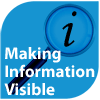 Key Priorities for Visibility Projects
Key Priorities for Visibility Projects
Jinfo Blog
21st April 2015
Abstract
The comprehensive FreePint Report: Research into Visibility 2015 has now been published. This blog item provides some highlights from the report, such as barriers to making content visible, and key priorities for visibility projects.
Item
 FreePint's research into "visibility" - how well users find the information they need at the point of need - highlighted that in order for information discovery to be successful three components must be in alignment: user behaviour, technology and content.
FreePint's research into "visibility" - how well users find the information they need at the point of need - highlighted that in order for information discovery to be successful three components must be in alignment: user behaviour, technology and content.
Key Priorities for Visibility Projects
What do organisations priorititise when they work on the challenge of visibility? Our research identified four areas rated most highly in terms of goals and objectives:
- Getting value from the money we spend on content
- Demonstrating usage to support purchase and renewal decisions
- Making sure users have vetted, valid information
- Protecting against copyright violations.
Whilst these are listed in order of priority given, highest first, all were rated as "very important" by our respondents.
When we analysed free-form comments, the importance of reliable usage data came through strongly as it enables information managers to react to usage and search data, to further understand users' search strategies and better improve results.
Technology
Technology solutions mentioned ranged from federated or enterprise search solutions to big data technology, visualisation tools and widgets, with corporate intranets proving the most used solution. For each type of technology, user satisfaction/dissatisfaction is roughly evenly split.
We found clear distinctions between industries, with federated search more likely to be implemented in educational environments and pharmaceutical companies, corporate intranets more widely used in legal, pharma and manufacturing, and visualisation tools more likely to be used in pharma and manufacturing.
Content
In terms of the content rated most important in terms of visibility, licensed or purchased content came first, closely followed by internal knowledge and then web-based content.
There are a number of barriers to making content visible, but our respondents rated the top four as:
- Information overload
- Cost and licensing issues
- Users' use of free search engines
- Coping with technology.
User Behaviour
A critical role of information centres is to work on influencing user behaviour, and our respondents rated organisation-provided training as their priority activity in this area.
Vendor-provided training was rated third, after "other" - the section which comprised free-form responses which varied from one-to-one training to appointing champions and using dedicated email shots.
Budgets and Decision-Makers
Nearly 40% of those surveyed have budget that is or could be used toward supporting or improving visibility, whilst for 30.4% of respondents that budget is managed elsewhere, in areas from administration to corporate strategy and IT. The IT department is the primary decision-maker in terms of technology.
However, information managers have unique expertise around how technology can and should apply to the project of visibility, and once responses are analysed without the IT department we start to see more clearly that libraries are part of the mix of live influence and decision-making around discovery.
Survey Sample
The survey collected input from 145 information managers from a range of industries including banking and finance, law, manufacturing, consulting and biotech.
Whilst the average number of staff in the information centres surveyed was 10.48 and median five, the lowest number was one and the highest 100. The number of staff they are required to support was an average of 7,625 and median of 1,650 - whilst the lowest number was less than 10 and the highest 100,000.
Find Out More
FreePint Subscribers can login now to read the full 32-page PDF "FreePint Report: Research into Visibility 2015" containing all the findings of the survey. This includes information on how satisfied information managers are with their efforts into making information visible, definitions of "visibility", and a set of practical next steps for each of the three essential areas: user behaviour, technology and content.
This Blog Item is part of the FreePint Topic Series "Making Information Visible".
- Blog post title: Key Priorities for Visibility Projects
- Link to this page
- View printable version
- Vendor Market Overview - Making Information Visible
Monday, 13th April 2015 - Facilitating Discovery and Delivering Awareness for Users
Monday, 30th March 2015 - The Building Blocks of Visualisation - Part 1 of 2
Monday, 30th March 2015 - What Does it Take To Do Visualisation Well?
Tuesday, 24th March 2015 - Eight Steps to Good Management for Visible Information
Tuesday, 3rd February 2015
- Introduction to FreePint's Research into Visibility
Wednesday, 25th March 2015 - Defining Barriers and Opportunities in Visibility - Preliminary Survey Results
Tuesday, 24th February 2015
- FreePint Report: Research into Visibility 2015
Monday, 13th April 2015
Register for our next Community session:

Team demand and AI
22nd January 2026
Latest on our YouTube channel:
Read on the Blog:
December 2025 update
3rd December 2025
- Team roles and AI (Community) 26th February 2026
- Team demand and AI (Community) 22nd January 2026
- Transforming knowledge management at BASF – GenAI and the evolution of QKnows (Community) 10th December 2025